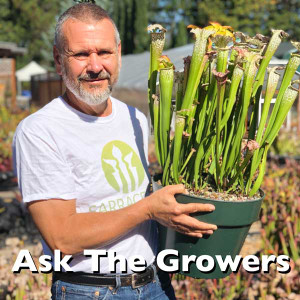December 31, 2022
Q/A #7 - Mold on a Drosera filiformis in South Florida
QUESTION:
I had reached out to you guys several months ago as I noticed the rhizome of my
Drosera filiformis was developing a hair-like wrapping around it. At the time, you guys said that it was merely preparing for dormancy and sure enough it has since entered its dormant state. Today, however, I noticed that what appears to be another hair-like material growing on the bud, and I am not sure if it is intentional or some sort of mold growing on it. I lost a Drosera several years ago during dormancy for the same reason, so I am trying to avoid this from happening. I live in South Florida, by the way. Also, should I trim the dead strands or continue to leave them attached to the bud? Thanks.
(Submitted in January 2021.)

RESPONSE BY JEFF DALLAS:
That is definitely a fungal issue. First, trim the dead leaves off since they can also harbor fungal spores. Since you have some botrytis developing, you need to be aggressive. Use a sulfur fungicide. It has low toxicity with humans and animals. It's available in spray bottles at your local garden center. Make sure to saturate the hibernacula (resting bud) when you spray it. Follow the directions for frequency of re-application.
The other option is to use a systemic fungicide, such as propiconazole. But most systemic fungicides are available only in concentrate form, so it makes sense to use it if you have a large collection to treat. They also tend to be more toxic to animals, which is why we don't recommend using it except as a last resort, such as treating very rare and expensive plants. Fortunately, your plant is easily replaceable, so start with the sulfur fungicide first.
The climate in South Florida also might exacerbating this problem. That area is much closer to a tropical climate, which means you're in USDA zone 9b or 10. Drosera filiformis prefers cool winters. (D. filiformis occurs naturally from Canada to the Florida Panhandle, but no populations exists south of that.) So, this might be why you keep experiencing fungal infection with these plants. If you want to grow North American sundews, Drosera intermedia, D. capillaris, and D. tracyi might be better options for you. These plants can deal with extended periods of warmth in winter. They can also deal with muggy summers.
Regardless of the type North American sundew you grow, it would be a good idea to spray preventatively each year with the sulfur fungicide when the plants go dormant since this has been an ongoing battle for you. Also, be sure the plants are out in the open and not under any kind of awning or overhang. You want them getting rained on, and exposed to UV light. We've always found plants grown out in the open have far fewer problems than those in the cold-frame greenhouses over the winter.
• Submitted in January 2021. The original question and response have been edited for publication.
• With a database of thousands of questions, we will publish a Q&A every few days or so.
• To search for similar posts, click on a hashtag below or use the site's search function.
• To submit a carnivorous plant question, visit Ask the Growers.

